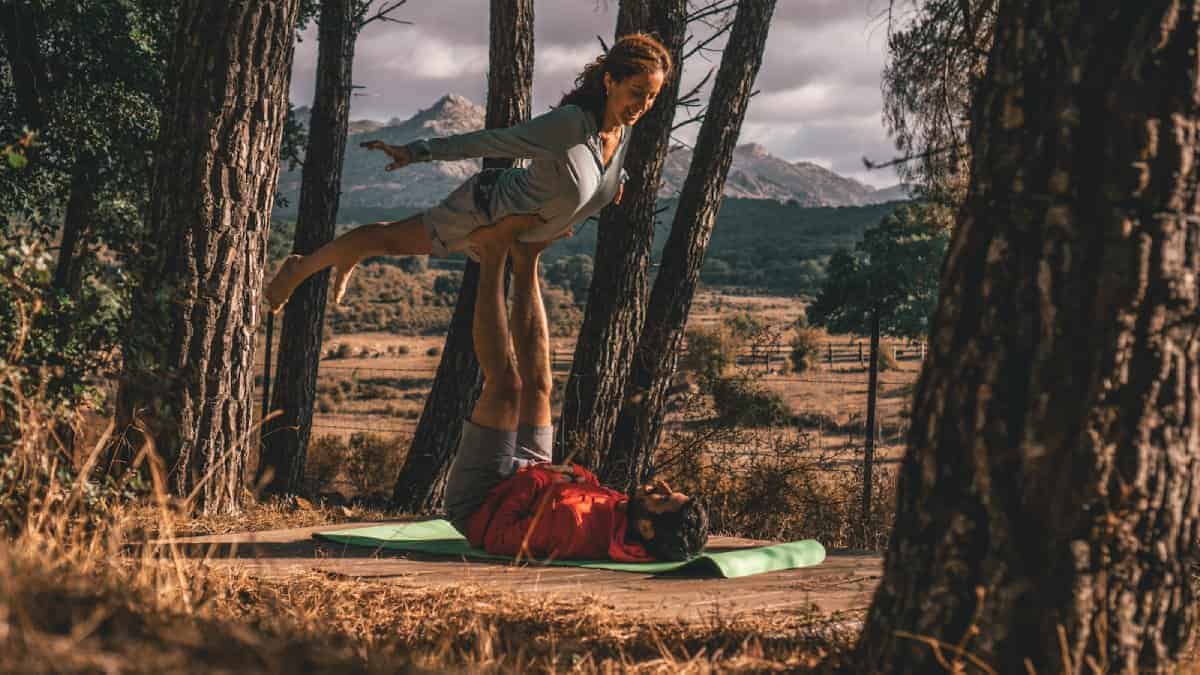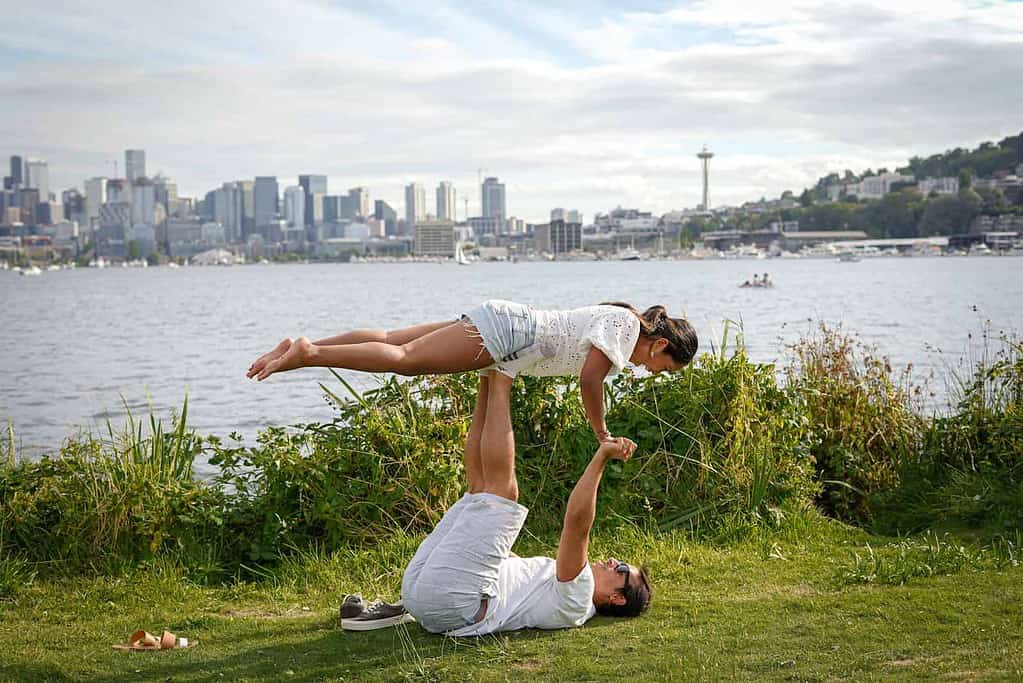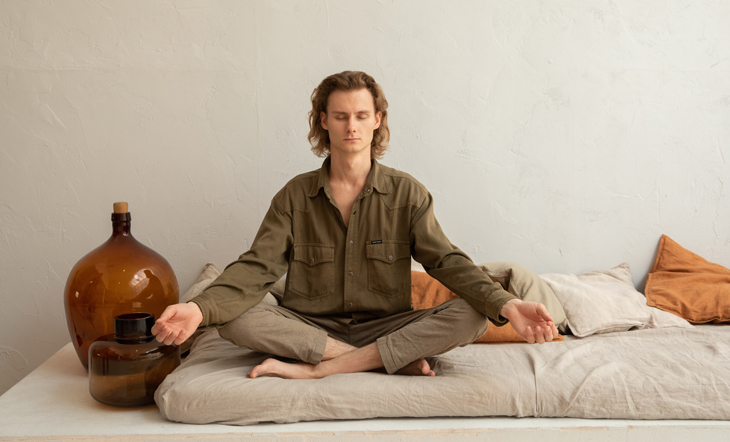Acro Yoga for Beginners – The Best Acro Yoga Poses To Do With A Partner
The post Acro Yoga for Beginners – The Best Acro Yoga Poses To Do With A Partner appeared first on The Yoga Nomads.

Do you want to make your yoga practice more fun and creative while gaining new friends or deepening your connection with your partner?
If so, why not try acro yoga?
This unique style of yoga is quickly becoming popular all over the world. Nowadays, it’s not unusual to encounter groups of acro-yogis at the beach or park, and there are more and more acro-yoga classes popping up all over the place.
So if you’re wondering how to do yoga with your partner or friend and are looking for easy acro yoga poses to try, look no further.
In this article, I’m sharing 10 beginner-friendly acroyoga poses and tips on how to have a fun and safe practice.
What Is Acro Yoga?
Acro yoga, also known as partner yoga, is a yoga practice that blends traditional Hatha yoga, acrobatics, and Thai massage. You need two people for an Acro yoga practice: the flyer and the base.
The base is the person on the bottom, who usually lies down with their back on the floor, holding the flyer’s weight. The flyer then practices yoga poses while elevated by the base.
It is also best to have a spotter who helps the base and flyer get into the correct position and stay safe. This could be the Acro yoga teacher or a more experienced practitioner.
Is Acro Yoga Hard?

Acro yoga is challenging, especially for beginners not used to working with a partner in this way. Both the base and the flyer need a good amount of strength and stability; however, the strongest and heaviest person is usually the base. On the other hand, the flyer is the lightest and most flexible person, who also needs to have a good sense of balance.
Aside from strength and balance, communication is one of the most challenging parts of Acro yoga. The success of the postures primarily comes down to how well you communicate with your partner.
Acro yoga takes time to get good at, but while you might find it difficult initially, you’ll have tons of fun from the first session. As long you maintain a beginner’s mindset and don’t take it too seriously, Acro is a super fun practice.
10 Beginner-Friendly AcroYoga Poses
Want to give Acro yoga a go? Here are ten beginner-friendly Acroyoga poses to help you get started.
Plank On Plank

“Plank on Plank” is one of the best easy acroyoga poses to learn and helps both yogis build arm and core strength.
The base starts by getting into a standard plank pose, then the flyer does the same position on top of them, facing the other way.
So, the flyer’s feet rest on the base’s shoulder blades, and their hands grab hold of the base’s ankles. Both yogis keep their hips lifted in line with their bodies and cores firmly engaged.
To get into the pose, the flyer should grab hold of the ankles and slowly extend one leg at a time.
Front Bird Pose

Front bird (also called front plank) is typically practiced after plank on plank.
In the front bird, the base lays in a “legs up the wall” style position with their back on the ground and legs and arms raised to 90 degrees. The flyer then rests their hips over the base’s feet and joins their hands in the base’s hands.
Both the base and the flyer keep their arms straight. The flyer then fully extends their legs behind them, focusing on balancing while the base engages their core, legs, and arm muscles.
To get into the pose, the base should start with their knees bent, pressing into their chest as the flyer leans their hips over the feet. Once the flyer is in position, the base extends their legs straight.
Folded Leaf Pose

The folded leaf is a fab therapeutic flying posture that you can do directly from the front plank. It gives a wonderful spinal stretch to the flyer.
Starting from the front plank position, the base turns their feet out to create a V shape in the flyer’s hips. This allows the flyer to lean forward without falling. Then, as the base focuses on stabilizing their legs, they slowly bend their elbows to allow the flyer to fold forward.
Both yogis release their hands, and the base brings theirs to the ground while the flyer lets theirs hang by the base’s hips. Alternatively, the flyer can gently hold onto the base’s neck to get a deep stretch into the side body and arms.
Partner Forward Folds

Partner forward folds are a nice counterpose after the plank poses and other strength-building asanas. You can do these forward folds seated or standing. Both give a deep stretch to the spine and hamstrings.
For the standing variation, both yogis stand back to back with their feet slightly wider than hip distance. They then interlock their arms with the base’s elbows underneath.
From here, the base starts to lean forward into a 90-degree bend (so the upper body is parallel to the ground). Finally, the flyer lifts off the ground and extends their legs into the air.
High Flying Whale Pose

High flying whale pose gives a deep chest and shoulder opening to the flyer while the base continues to build strength in the entire body.
The bases start in the same position as the front bird with their back on the ground and feet lifted. The flyer stands close to the base’s head, framing their feet around their ears.
The base grabs the flyer’s ankles and extends their legs towards their head to place their feet on the flyer’s upper back. The flyer engages their entire body while leaning back into the base’s feet.
As the base support’s the flyer’s weight with their feet, they slowly lift the flyer’s feet off the ground, allowing the flyer to move into the backbend. Then, the flyer can extend their arms overhead.
Throne Pose

The throne pose is a super fun acroyoga pose that continues to work on balance and strength. Both yogis begin in the same starting position as the high-flying whale, with the base lying on their back and the flyer standing with their feet framing the base’s neck.
The base gently grabs the flyer’s ankles and then lifts their legs, bringing the soles of their feet close to the flyer’s hips. The flyer then bends their knees to sit into the base’s hands, and the base shifts their hands from the flyer’s ankles to their feet and lifts them off the ground.
The base brings their legs and arms into a 90-degree raised position with the flyer sitting on the feet with knees bent and feet resting in the base’s hands. Then, the flyer sits straight while choosing whichever arms variation they want to do.
Downward Facing Dog L Shape

The downward-facing dog l shape is perfect for doing after the previous poses where the base has engaged their muscles for a long time.
In this position, the base gets a much-needed lengthening in the spine as the flyer presses their feet into the base’s low back (similarly to how a teacher gives an assist in downward dog). The flyer works on building their strength on a supported handstand variation.
The base starts by coming into a downward-facing dog. Next, the flyer stands close to the base’s hands, facing away from them. Then, with a wide stance, the flyer folds forward and places their hands directly in front of the bases.
With their shoulders stacked over their wrists, the flyer lifts one foot at a time, placing them on the base’s lower back. Then, while engaging their core and arms, the flyer extends their legs, coming into an upside-down l-shape.
Chair Pose On Shins

In this pose, both yogis build leg strength as the flyer also works on their balance. In addition, this shape gives the base gentle compression of the abdominal organs, improving digestion.
The base lays on their back and bends their knees, bringing their feet off the ground. They then extend their arms up, ready to assist the flyer safely into position.
The flyer gently places one foot on the base’s shin, taking the base’s hand for support. Then, they slowly shift their body weight onto the base before lifting their other leg and placing the foot on the other shin.
From here, the flyer focuses on finding balance by letting go of the base’s hands and entering a standing position. When ready, they bend their knees into a chair pose, reaching their arms overhead.
Dancer’s Pose

The dancer’s pose is a bit more complex than the previous asanas, bringing the flyer into an inverted backbend. It is essentially an upside-down dancer’s pose where the flyer is supported by the body weight of the base.
The base lays on their back with their legs up. The flyer stands at the bottom of the mat, facing away from the base. The base lowers their legs and places their feet on the flyer’s lower back as the flyer leans back into them.
The base then lifts their legs to bring the flyer’s hips directly other their own while supporting the flyer’s shoulders with their hands.
The flyer then extends one leg to the sky while bending the opposite knee. They then reach their arms behind them to grab hold of the foot of the bent knee and gently kick the foot into their hand, like in a regular dancer’s pose.
Fish On A Rock

One of the best acro yoga positions to end a session is fish on a rock. It has a therapeutic effect for both yogis, giving a lovely back and hip opening.
The base comes into a child’s pose with their knees wide. Next, they extend their arms in front of them and rest their forehead on the ground. The flyer then lays their back over the base’s spine before extending their legs and arms for a full body stretch.
Top Tips For Partner Yoga
Now you know the most common acro yoga poses, follow these helpful tips to make your acro yoga practice as safe and fun as possible.
Don’t Forget To Warm Up
One of the most important things to remember before doing acro yoga poses is to warm up properly. Spend at least 10 minutes doing some sun salutations and other common yoga poses before you start working with your partner.
The same goes for the end of the session. Include cool-down postures, like a supine twist and happy baby, followed by a well-earned savasana.
Take It Slow

Even if you’ve been practicing Hatha or Vinyasa yoga for a long time, don’t rush into acro yoga, attempting the most advanced poses on your first day. Acro yoga is totally different from traditional yoga, so it will (and should) feel like being a beginner again.
Focus on the beginner-friendly acroyoga poses to start, as these will help you build your strength, improve body awareness in the air, and find the correct alignment.
I recommend reading Move, Connect, Play: The Art and Science of AcroYoga to learn more about the practice. In this book, author and founder of acroyoga international, Jason Nemer, details the 10 key areas you need to train for acro yoga. He then gives specific exercises and routines for each one.
Use a bolster
If you’re the base, placing a bolster under your hips is helpful when laying in the usual starting position with the back on the ground and legs up. The Gaiam rectangular bolster will support your hips and back and help you maintain the raised leg position, especially if you have tight hamstrings.
Use A Bigger Yoga Mat
An extra long and wide yoga mat is ideal for practicing yoga with a partner. The CAMBIVO TPE Yoga Mat is 10 cm wider and 30 cm longer than standard-size yoga mats, giving you all the necessary space. In addition, it is 6mm thick and lightweight at just 1.25 kg, so it is a top choice for outdoor acro yoga sessions.
Final Thoughts On Acro Yoga Poses
While acro yoga is far from the traditional yogic practice we know and love, there are many reasons to include it in your yoga routine. It will help you build strength, increase flexibility, improve communication skills, and deepen your relationships.
Have you tried acro yoga before? What did you think of it?

 MikeTyes
MikeTyes 
































